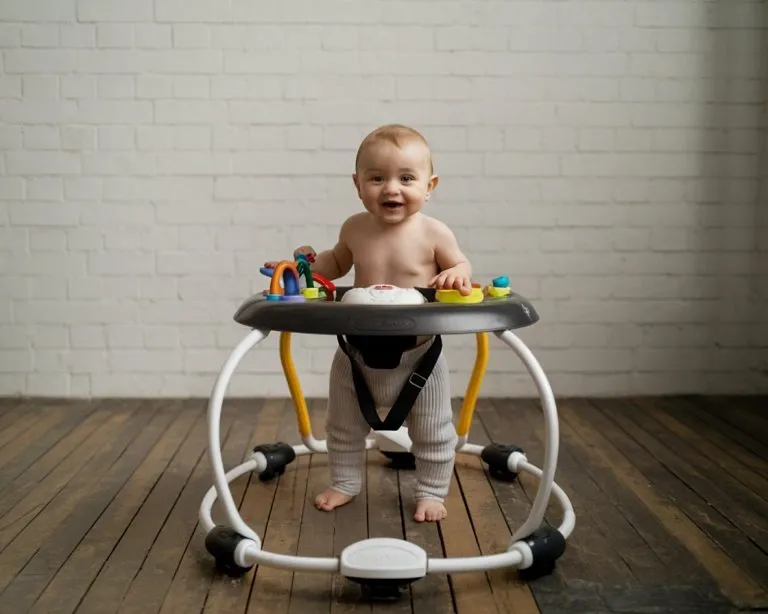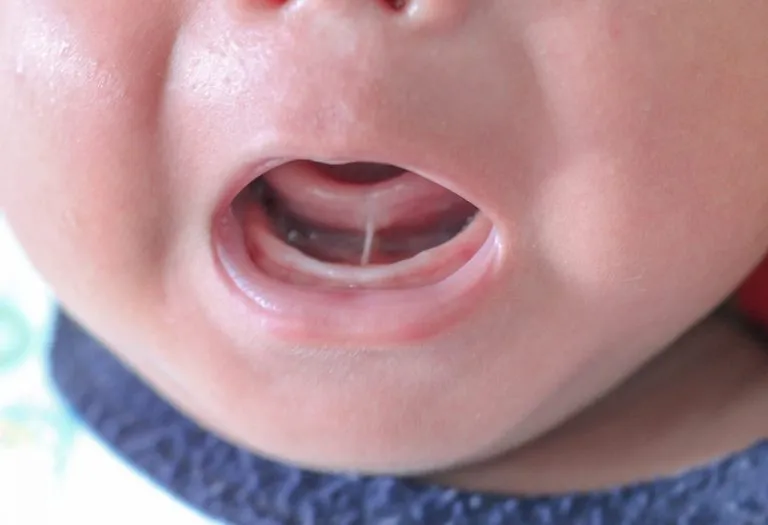Baby Exersaucer – Pros & Cons of Using It
- What Are Baby Exersaucers?
- Are Exersaucers Safe for Babies?
- When Can Baby Use Exersaucer?
- Benefits of Using Exersaucers for Infants
- Disadvantages of Using Exersaucers
- Tips to Use Exersaucers Safely for Your Baby
- Some Alternatives to Exersaucers
- What Age Do Baby Stop Using Exersaucers?
- FAQs
If you’re a parent or caregiver, you’ve probably seen or heard of a baby Exersaucer, those colourful, bouncy activity centres that keep little ones busy and happy. They seem like a great way to give your baby some fun playtime while you get a few things done. But are they really as helpful as they look? As parents, we often ask this question to the paediatrician – Are Exersaucers good or bad for babies?
This topic has been controversial for a long time as there are different opinions on it. Like most baby gear, Exersaucers have their good sides and not-so-good sides. In this article, we’ll take a closer look at the pros and cons so you can decide if it’s the right choice for your baby.
What Are Baby Exersaucers?
An Exersaucer is a stationary play centre for your baby that has a round base and an elevated seat for them to sit. They are conceptually similar to a walker, but without wheels (1). The main role of an Exersaucer is to let your baby remain upright while playing or during the day in general.
Are Exersaucers Safe for Babies?
Exersaucers can be safe for babies when used in moderation and under supervision, typically for no more than 15-20 minutes at a time. Paediatricians warn that using Exersaucers for too long can slow down a baby’s ability to crawl and walk.
When Can Baby Use Exersaucer?
The age for an Exersaucer is typically around 6 to 7 months, when babies can hold their head steady and sit up with support. It’s important not to use it too early, as babies need time to build strength through natural movements like tummy time and floor play.
Benefits of Using Exersaucers for Infants
Exersaucers can provide several benefits for infants, offering them a safe space to play, explore, and develop motor skills. Below is a list of the benefits of using Exersaucer for baby.
- It gives parents/caretakers some break from handling the baby all day long.
- When baby and mom are the only two members who stay at home throughout the day, an Exersaucer is a blessing as it allows mom to go for a shower, cook and manage other household chores.
- It keeps the baby entertained while the parent/caregiver is away for a while
- Walkers can cause injury to babies as they make baby movement easy which could lead the baby to a fall. Exersaucers don’t have this disadvantage.
Disadvantages of Using Exersaucers
While Exersaucers offer some benefits, there are also a few disadvantages to consider. Here are a few of the main disadvantages of using Exersaucers for infants (2).
- It is not the best thing for your baby’s posture. The importance of correct posture cannot be denied; it is even more important during growing years. Exersaucers completely defeat the purpose.
- Your baby is never as comfortable to sit in an Exersaucer as he will be when sitting on the bed or couch. So when it comes to your baby’s comfort, there is a big question mark.
- Babies who spend a lot of their waking hours in an Exersaucer eventually develop the risk of not being able to balance themselves when they attempt to walk without its support. Besides this, some babies also face challenges while standing upright without an Exersaucer. This is because their bodies are so used to even standing with the help of support that without support the body is unable to hold itself up strongly.
- Babies who sit in Exersaucers or walkers or high chairs for a long time develop a syndrome called ‘Container Baby Syndrome’. Babies who develop this syndrome have flat heads, tightness in the neck area and delayed muscle development which means delay in lifting head and hand, holding things, crawling, etc. They also go through delayed sensory and cognitive development (3).
- Spending too much time in one position can increase the risk of developing flat head syndrome (plagiocephaly) (4).
Tips to Use Exersaucers Safely for Your Baby
Exersaucers can be a fun and helpful tool for your baby’s development when used correctly. To ensure your baby’s safety and maximise the benefits, here are some important tips to follow:
- Always supervise your baby while they are in the Exersaucer to prevent accidents.
- Use the Exersaucer for short periods, no longer than 20-30 minutes at a time, to avoid over-reliance on it.
- Make sure your baby has strong neck and head control before using the Exersaucer, typically around 6 to 7 months old.
- Adjust the height of the Exersaucer to ensure your baby’s feet are flat on the floor to prevent strain on their legs.
- Regularly check the Exersaucer for loose parts or wear and tear to keep it safe for use.
- Place the Exersaucer on a flat, stable surface away from sharp objects or furniture that your baby could bump into.
- Allow your baby to spend plenty of time on the floor for crawling and other natural movements to encourage overall development.
- Limit the time your baby spends in the Exersaucer to promote better posture and avoid muscle weakness.
- Avoid using the Exersaucer as a substitute for active playtime or interaction with others.
- Keep the toys attached to the Exersaucer clean and free of small parts that could pose a choking hazard.
Some Alternatives to Exersaucers
While infant Exersaucers can be helpful, there are other great alternatives that can promote your baby’s development in a more natural way. Here are a few options to consider:
- Tummy Time Mats: Allow your baby to practice lifting their head, strengthening their neck, back, and arm muscles in a safe and flexible environment.
- Activity Gyms: These provide a safe space with hanging toys, mirrors, and textures, helping babies reach, bat, and kick while developing coordination and motor skills.
- Sensory Toys: Toys that engage your baby’s senses, such as textured balls, rattles, or soft books, can encourage reaching, grasping, and tactile exploration.
- Baby-safe Fabric Book: Soft, colourful fabric books can engage your baby’s sense of sight and touch while encouraging early learning through interactive pages and textures.
- Musical Mobile: A musical mobile can provide visual and auditory stimulation, helping your baby develop listening skills while keeping them entertained during tummy time or rest.
- Floor Playtime: Let your baby spend time on the floor, exploring their surroundings, which helps with muscle development and encourages crawling.
What Age Do Baby Stop Using Exersaucers?
Babies typically stop using Exersaucers around 9 to 12 months old, when they become more mobile and are ready to explore other activities, such as crawling, standing, or cruising.
FAQs
1. How do I choose the right Exersaucer for my baby?
When selecting a Baby Exersaucer, consider features like adjustable height, safety harness, and stability. Choose one with appropriate toys to stimulate your baby’s senses and encourage learning. Make sure it’s easy to clean and that it’s made of non-toxic materials. Always read reviews and check the product safety ratings.
2. Is Exersaucer better than a baby walker?
Yes, in many cases. Unlike traditional walkers with wheels, which pose fall and injury risks, Exersaucers are stationary and generally considered safer. They allow babies to play upright without the danger of rolling into unsafe areas, making them a safer alternative for supervised play (5).
At the end of the day, each family is in a different situation and has different dynamics/challenges to cope with. Each parent has to decide whether they would want to use an Exersaucer for their baby or not. The choice is yours. However, if you choose to use it, our recommendation would be to keep its use at minimal. In the long run, using an Exersaucer does more harm than good for your baby.
References/Resources:
1. Children’s Rehabilitation Institute TeletonUSA – CAUTION WITH WALKERS, JUMPERS, EXERSAUCERS
2. PubMed – Exersaucers: a comprehensive review of their developmental and safety implications
3. Cleveland Clinic – What Is Container Baby Syndrome?
4. Nemours KidsHealth – Flat Head Syndrome (Positional Plagiocephaly)
5. American Academy of Pediatrics – Baby Walkers: A Dangerous Choice
Also Read:
Baby Monitors
Easy Exercises for Infants
Muscle Stretching Exercise for Infants
Fun Exercises Mother Can Do with Baby
At What Age Your Baby Can Use a Walker?
Was This Article Helpful?
Parenting is a huge responsibility, for you as a caregiver, but also for us as a parenting content platform. We understand that and take our responsibility of creating credible content seriously. FirstCry Parenting articles are written and published only after extensive research using factually sound references to deliver quality content that is accurate, validated by experts, and completely reliable. To understand how we go about creating content that is credible, read our editorial policy here.























